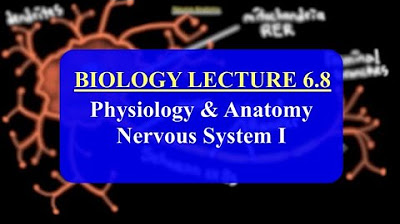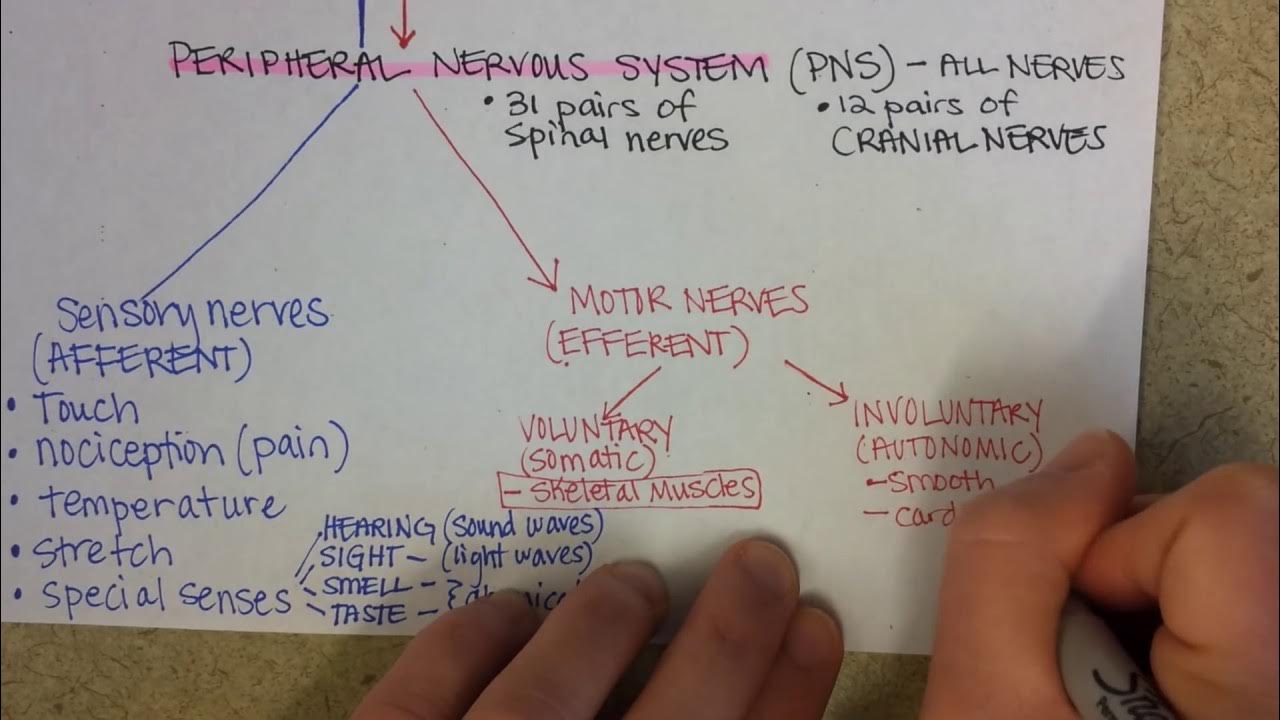IMAT Biology Lesson 6.10 | Anatomy and Physiology | Muscle Contraction
Summary
TLDRThis video from Med School EU delves into the skeletal system, focusing on the innervation of skeletal muscles by the nervous system. It covers muscle anatomy, including striations due to myosin and actin filaments, and physiology, particularly the sliding filament model of muscle contraction. The lecture explains the role of the sarcomere, sarcolemma, T tubules, and sarcoplasmic reticulum in muscle function. It also discusses the neuromuscular junction's role in initiating muscle contractions and the sources of ATP for muscle activity, including creatine phosphate, aerobic respiration, and lactate fermentation.
Takeaways
- 📚 The lecture focuses on the skeletal system, specifically the innervation of skeletal muscles by the nervous system and the anatomy and physiology of muscle contraction.
- 💪 Skeletal muscles are composed of striated muscle fibers, characterized by the presence of thick and thin filaments made up of myosin and actin, respectively.
- 🔬 The structure of a muscle fiber includes A, I, and M bands, and Z lines, which are crucial for defining the sarcomere, the basic contractile unit of muscle tissue.
- 🔍 Under a light microscope, the striations of skeletal muscle are visible due to the arrangement of thick and thin filaments, which are essential for muscle contraction.
- 🏋️♂️ Muscle contraction occurs through the sliding filament model, where thin filaments slide over thick filaments, causing the Z lines to move closer together.
- 🔄 The M line remains constant during contraction, while the A band and I band undergo changes in size, reflecting the movement of actin filaments towards the myosin filaments.
- 🌐 The sarcolemma, a cell surface membrane, plays a key role in muscle contraction, along with the T tubules and sarcoplasmic reticulum, which are involved in the propagation of action potentials and calcium release.
- 🚀 The neuromuscular junction is where the neuron communicates with the muscle fiber, initiating muscle contraction through the release of acetylcholine, which triggers action potentials in the muscle.
- 🔑 Calcium ions are pivotal in muscle contraction, as their release from the sarcoplasmic reticulum and binding to troponin cause a conformational change that enables myosin to bind with actin.
- ⚡ ATP is essential for muscle contraction, but its role is to terminate each contraction cycle by facilitating the release of myosin heads from actin, not to activate the contraction itself.
- 🔄 ATP supply for muscle contraction comes from various sources, including creatine phosphate for immediate contraction, stored ATP, aerobic respiration in the mitochondria, and lactate fermentation.
Q & A
What is the primary focus of the lecture in the provided script?
-The lecture primarily focuses on the skeletal system, specifically discussing the anatomy and physiology of muscle innervation and contraction.
What are striations in skeletal muscle, and what causes them?
-Striations in skeletal muscle are the banded patterns visible under a light microscope, caused by the arrangement of thick and thin filaments composed of myosin and actin, respectively.
What are the main components of the thick and thin filaments in skeletal muscle?
-The thick filaments are primarily composed of myosin, while the thin filaments are mainly composed of actin.
What is the role of the Z line in skeletal muscle structure?
-The Z line is important as it marks the sarcomere, which is the contractile unit of muscle, and it holds the thin filaments together.
What happens to the sarcomere during muscle contraction?
-During muscle contraction, the sarcomere shortens as the Z lines move closer together, and the actin filaments slide over the myosin filaments.
What is the sliding filament model, and how does it explain muscle contraction?
-The sliding filament model describes the process of muscle contraction where the thin actin filaments slide over the thick myosin filaments, pulling the Z lines closer and causing the muscle to contract.
What is the role of the sarcolemma in muscle fibers?
-The sarcolemma is the cell surface membrane of muscle fibers that covers them and has T tubules, which are important for muscle contraction.
What is the function of the T tubules and sarcoplasmic reticulum in muscle contraction?
-The T tubules are involved in the transmission of the action potential from the sarcolemma to the interior of the muscle fiber, while the sarcoplasmic reticulum releases calcium ions necessary for muscle contraction.
How does the neuromuscular junction facilitate muscle contraction?
-The neuromuscular junction is where the motor neuron binds to the sarcolemma, releasing acetylcholine that triggers action potentials in the muscle, leading to contraction.
What are the sources of ATP for muscle contraction, and how do they differ based on the type of activity?
-ATP for muscle contraction comes from creatine phosphate for immediate contraction, stored ATP for short-duration activities, aerobic respiration for sustained activities, and lactate fermentation for high-intensity, short-duration activities.
How does the calcium cycle within the sarcoplasmic reticulum contribute to muscle contraction and relaxation?
-Calcium is released from the sarcoplasmic reticulum during contraction to facilitate the binding of myosin to actin. After contraction, calcium is actively transported back into the sarcoplasmic reticulum, allowing the muscle to relax.
Outlines

このセクションは有料ユーザー限定です。 アクセスするには、アップグレードをお願いします。
今すぐアップグレードMindmap

このセクションは有料ユーザー限定です。 アクセスするには、アップグレードをお願いします。
今すぐアップグレードKeywords

このセクションは有料ユーザー限定です。 アクセスするには、アップグレードをお願いします。
今すぐアップグレードHighlights

このセクションは有料ユーザー限定です。 アクセスするには、アップグレードをお願いします。
今すぐアップグレードTranscripts

このセクションは有料ユーザー限定です。 アクセスするには、アップグレードをお願いします。
今すぐアップグレード関連動画をさらに表示

How your muscular system works - Emma Bryce

Development of the muscular system

IMAT Biology Lesson 6.8 | Anatomy and Physiology | Nervous System I

Muscle Tissue | Skeletal, Cardiac, and Smooth

Rangkuman IPAS KELAS 6 BAB 1: Bagaimana Tubuh Kita Bergerak?. Topik A: Rangka, sendi, dan otot

Nervous System Overview
5.0 / 5 (0 votes)
